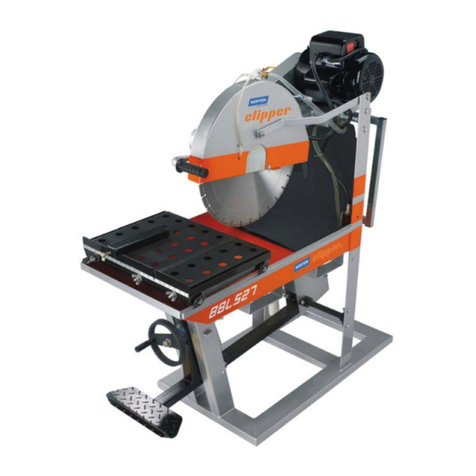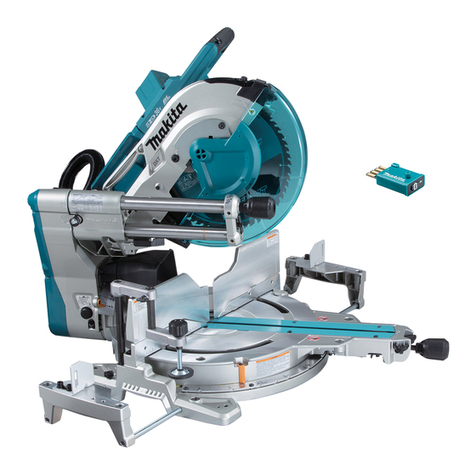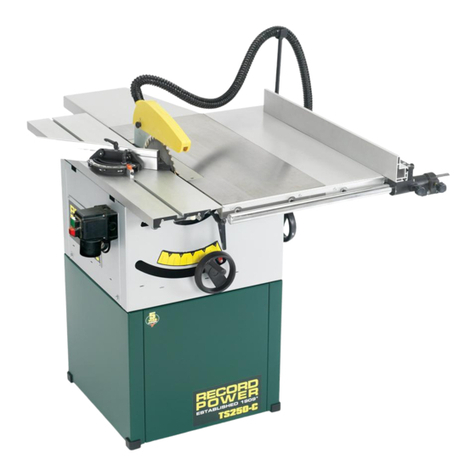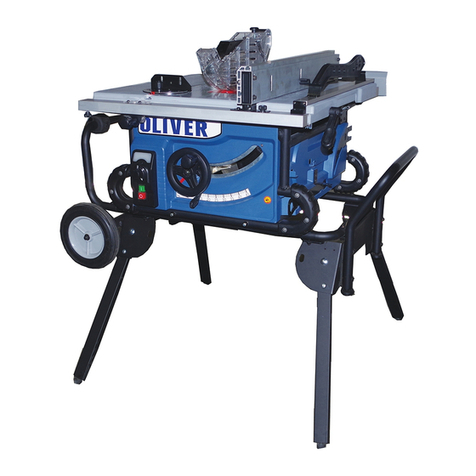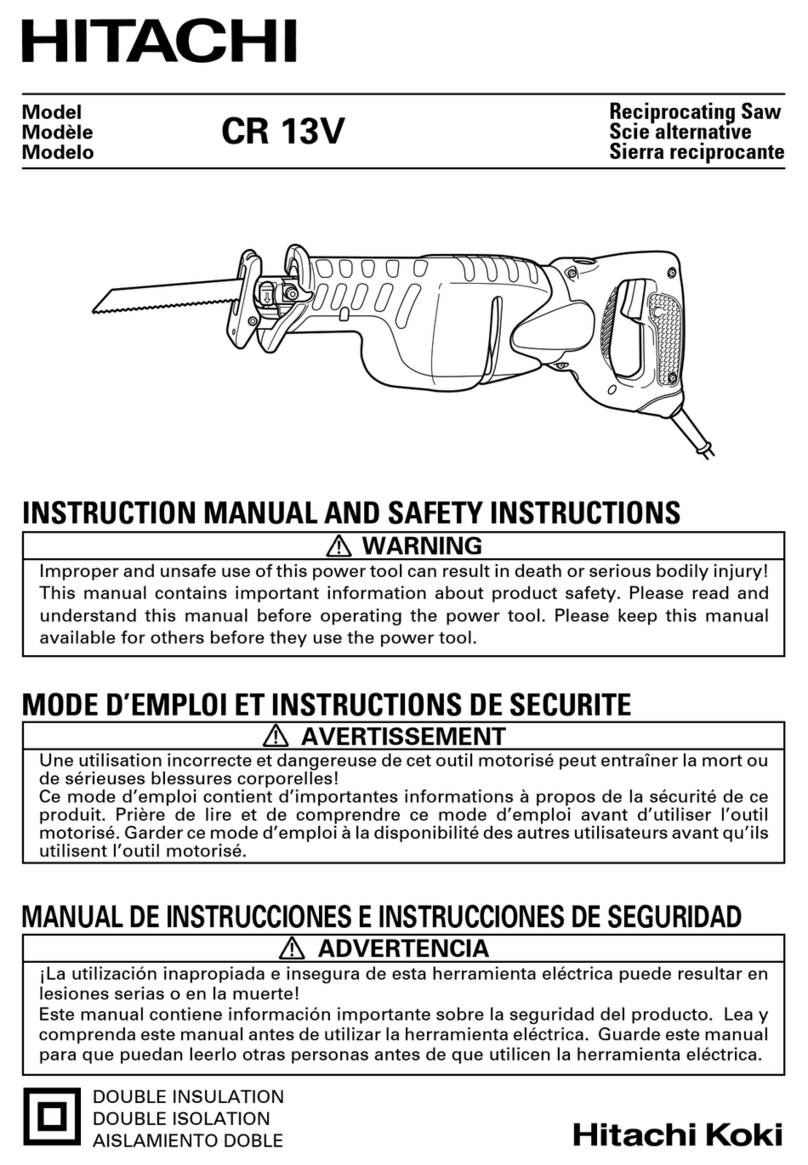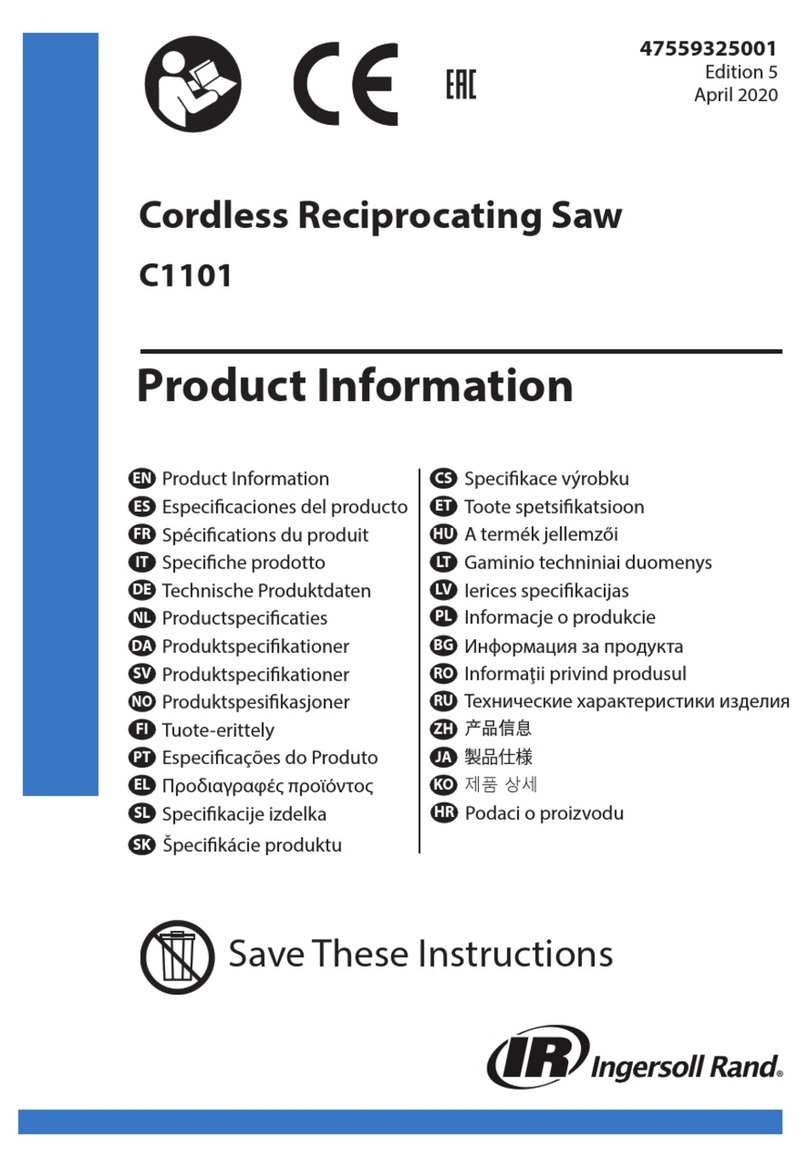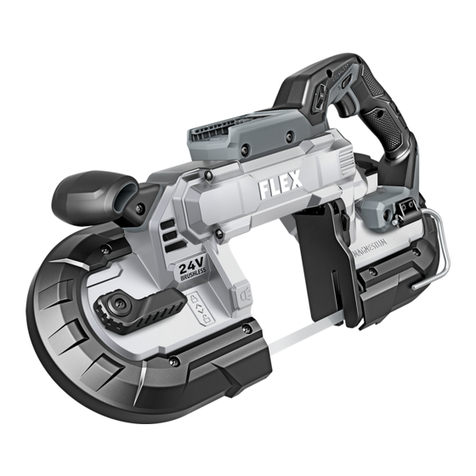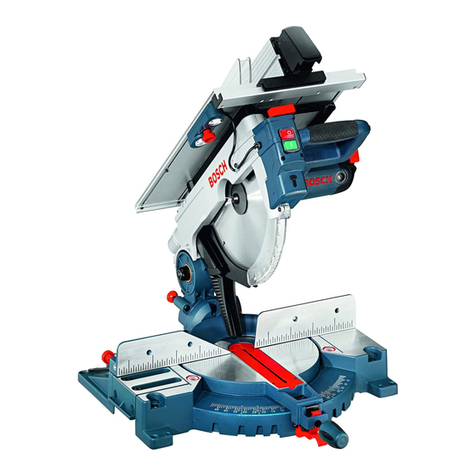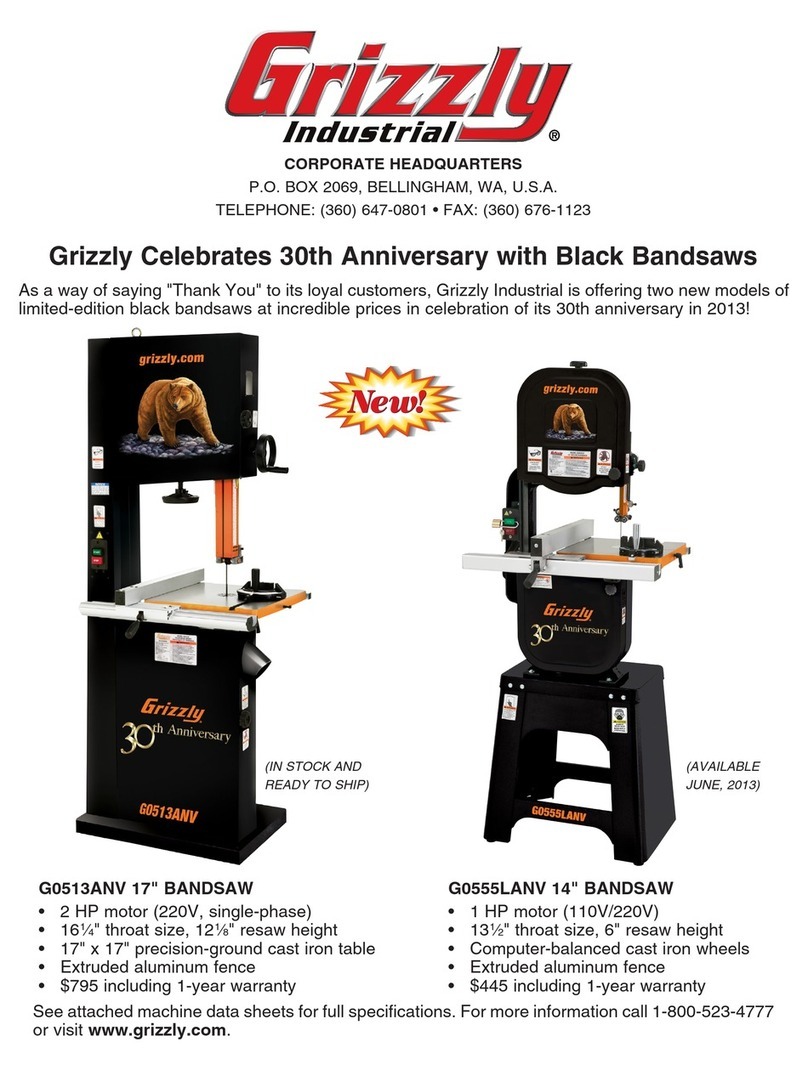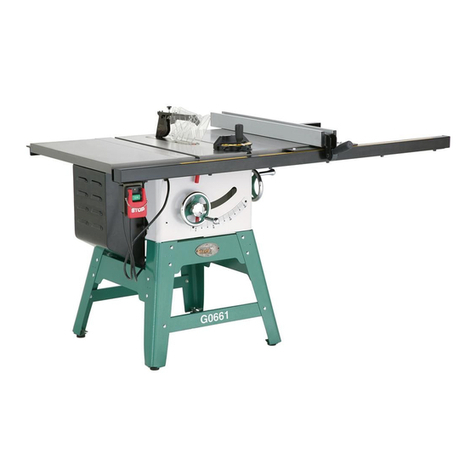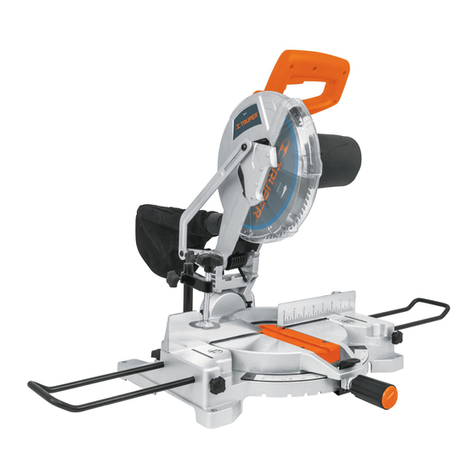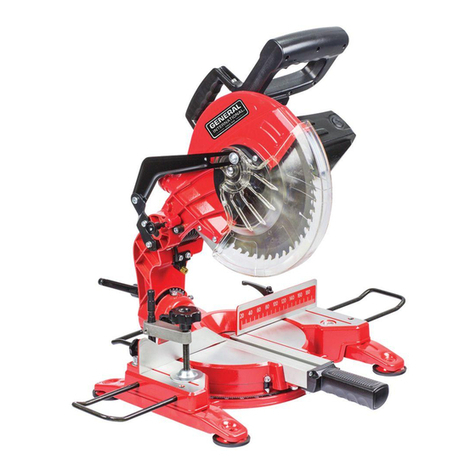Diamond Power Products CC7074 User manual

Page1
DIAMOND
P R O D U C T S
OPERATOR’S MANUAL
CONCRETE SAW
MODEL:
CC7074
Manual # 1801371

Table of Contents
Safety Precautions................................................. 1
Safety Alerts................................................................1
Proposition 65.............................................................1
Spark Arrester Requirement.......................................1
Respiratory Hazards...................................................1
General Safety............................................................2
Battery and Electrical Safety.......................................2
Blade Safety................................................................3
Blade Guard Safety.....................................................3
Fuel Safety..................................................................3
Engine Safety..............................................................4
Cutting Safety .............................................................4
Hydraulic Safety..........................................................4
Belt Safety...................................................................4
Transporting Safety.....................................................4
Introducing the CC7074......................................... 7
Controls.......................................................................7
Dimensions.................................................................9
Specifications............................................................10
Operating the CC7074......................................... 11
Tie-Downs.................................................................11
Footrest.....................................................................11
Weight Bar (Optional) ...............................................11
Spotlight....................................................................11
Handlebars................................................................11
Adjusting the Handlebars..............................................11
Fuel System..............................................................12
Adding Fuel...................................................................12
Blade Guard..............................................................12
Installing the Blade Guard.............................................12
Removing the Blade Guard...........................................13
Flange Guard............................................................13
Installing the Flange Guard...........................................13
Removing the Flange Guard.........................................13
Diamond Blades........................................................13
Inspecting the Blade .....................................................13
Blade Speed.................................................................14
Wrench .........................................................................14
Installing the Blade........................................................14
Removing the Blade......................................................15
Engine.......................................................................15
Tasks Prior to Starting the Engine ................................16
Starting the Engine .......................................................16
Stopping the Engine......................................................16
Speed Control Lever.................................................16
Blade Lowering Speed..............................................17
Water Supply ............................................................17
Using the Water Supply................................................17
Cutting Guides..........................................................17
Adjusting the Front Pointer ...........................................17
Adjusting the Rear Pointer(s)........................................18
Concrete Cutting.......................................................18
Helpful Hints Prior to Cutting ........................................18
Tasks Prior to Cutting...................................................18
Making a Cut ................................................................18
Making a Cut Using the Blade Depth Stop ...................19
Continuing a Partial-Cut................................................19
Finishing a Cut..............................................................19
Maintaining the CC7074.......................................21
Maintenance Overview.............................................21
Daily .............................................................................21
Every 100 Hours...........................................................21
Every 250 Hours...........................................................21
Every 500 Hours...........................................................21
Part Lubrication ........................................................21
Water Filter Strainer (Optional) ................................21
Speed Control Lever.................................................22
Adjusting the Lever Tension.........................................22
Adjusting the Spring Plungers ......................................22
Inner Blade Flange...................................................22
Installing the Inner Blade Flange..................................22
Removing the Inner Blade Flange................................22
Drive Alignment........................................................22
Drive Alignment............................................................22
Wheels......................................................................22
Replacing the Front Wheels .........................................23
Replacing the Rear Wheels..........................................23
Maximum Cutting Depth...........................................23
Handlebar Cylinder Rod...........................................24
Removing the Cylinder Rod..........................................24
Connecting the Cylinder Rod........................................24
Battery ......................................................................24
Battery Type.................................................................25
Servicing the Battery ....................................................25
Electrical System......................................................25
Radiator....................................................................25
Adding Radiator Fluid...................................................25
Changing the Radiator Fluid.........................................26
Hydraulic System......................................................26
Adding Fluid to the Hydraulic Lift Pump........................26
Adding Hydraulic Fluid to the Reservoir Tank...............27
Replacing the Hydraulic Oil Filter .................................27
Upper Gearbox.........................................................27
Changing the Upper Gearbox Oil .................................27
Draining the Upper Gearbox Heat Sink ........................27
Lower Gearbox.........................................................28
Changing the Lower Gearbox Fluid..............................28
Cleaning the In-Line Oil Suction Filter ..........................28
Belt Sheaves ............................................................28
Removing the Belt Sheaves .........................................28
Installing the Belt Sheaves ...........................................29
Blade Drive Belts......................................................29
Tensioning/Replacing the Blade Drive Belts.................29
In-Line Fuel Filter......................................................30
Engine ......................................................................30
Cleaning the Engine.....................................................30
Air Cleaner................................................................31

Restriction Indicator......................................................31
Rubber Dust Ejector Boot.............................................31
Cleaning/Replacing the Outer Primary Filter.................31
Replacing the Inner Safety Filter...................................32
Storing.......................................................................33
Disposal....................................................................33
References .......................................................... 35
Appendix A................................................................35
Serial Tags....................................................................35
Appendix B................................................................36
Daily Maintenance Task Chart......................................36
Appendix C ...............................................................37
Belt Tension Settings....................................................37
Appendix D ...............................................................38
Troubleshooting............................................................38
Appendix E................................................................39
Additional Resources....................................................39

1
Safety Precautions
Operate the CC7074 Concrete Saw and all of its
components according to this manual. Failure to comply
with and understand the following safety, operation and
maintenance instructions can result in serious injuries
and/or death. All operators must be properly trained or
supervised by experienced personnel prior to using this
saw and should understand the risks and hazards
involved. Diamond Products discourages improper or
unintended saw usage and cannot be held liable for any
resulting damages.
Saw modifications should be made by Diamond
Products to ensure safety and design. Any modifications
made by the owner(s) are not the responsibility of
Diamond Products and void all saw warranties if a
problem arises as a result of the modification.
Refer to the CC7074 Parts List for additional information
and part diagrams. Refer to the engine manual and
manufacturer as the primary source for all safety,
operations, and maintenance instructions regarding the
engine. Prior to operating, record the saw’s serial
number, and the engine’s model and serial numbers in
Appendix A.
Notice: The information in this manual may be
updated at any time!
Safety Alerts
DANGER
Serious injuries and/or death will occur if these
instructions are not followed.
WARNING
Serious injuries and/or death could occur if these
instructions are not followed.
CAUTION
Mild and/or moderate injuries could occur if these
instructions are not followed.
Proposition 65
WARNING
Engine exhaust and some of its
constituents are known to the State of
California to cause cancer, birth defects,
and/or other reproductive harm.
Spark Arrester Requirement
WARNING
In the State of California it is a violation of section
4442 or 4443 to use or operate the engine on any
forest-covered, brush-covered, or grass-covered
land unless the engine is equipped with a spark
arrester, as defined in section 4442, maintained in
effective, working order or the engine is
constructed, equipped, and maintained for the
prevention of fire pursuant to section 4443.
Respiratory Hazards
WARNING
Concrete cutting produces dust and fumes known
to cause illness, death, cancer, respiratory
disease, birth defects, and/or other reproductive
harm. Safety protection techniques include, but are
not limited to:
Wearing gloves.
Wearing safety goggles or a face shield.
Using approved respirators.
Washing work clothes daily.
Using water when wet cutting to minimize
dust.
Washing the hands and face prior to
eating/drinking.
For additional safety and self-protection
information contact your employer, the
Occupational Safety and Health Administration
(OSHA), and/or The National Institute for
Occupational Safety and Health (NIOSH).

2
General Safety
Read and understand all safety, operations, and
maintenance instructions provided in this manual
prior to operating or servicing the saw.
Keep saw components clean and free of slurry,
concrete dust, and debris.
Inspect water hoses prior to operating the saw.
Clean, repair, or replace damaged components.
Raise the saw to a proper height for access when
working underneath the saw. Use chocks to block
the wheels, and fit blocks or jacks under the frame
edges.
WARNING – Do NOT work on saw
using the hydraulic lift system to keep
the saw in the raised position for
maintenance or repair. Accidental loss
of hydraulic pressure could cause the
saw to drop suddenly, causing serious
injury or death.
When using a jack to raise the saw, place the jack
against a solid, flat area under the frame base to
properly support the saw.
Repair the saw immediately when a problem arises.
Replace saw decals if unreadable.
Dispose of all hazardous waste materials according
to city, state, and federal regulations.
Always have a phone nearby, and locate the nearest
fire extinguisher and first aid kit prior to operating the
saw.
Operate the saw wearing flame resistant clothing.
Always wear safety glasses when removing retaining
rings.
Persons under the statutory age limit should not
operate the saw.
Keep all body parts away from rotating machinery.
Replace all guards and access panels (unless stated
otherwise) prior to operating the saw.
Always pivot front of blade guard fully to avoid
serious injuries.
DO NOT assume the saw will remain still when in
neutral or when parking/stopping the saw on a
slope. Chock the wheels to help prevent
unnecessary movement.
DO NOT:
Drop equipment, supplies, tools, etc., when handling
to help prevent injuries.
Lift and carry equipment, supplies, tools, etc., that
are too heavy and/or cannot be lifted easily.
DO NOT (cont.):
Operate the saw without using the appropriate
safety equipment required for the work task.
Operate or service the saw with any clothing, hair, or
accessories that can snag in the machinery, which
could lead to serious injuries or death!
Operate the saw using attachments not associated
with or recommended for the saw.
Operate the saw around combustible materials or
fumes to prevent fires/explosions.
Operate the saw with anyone near the work area or
within the direct line of the blade.
Operate the saw until all unnecessary materials
have been removed from the work area.
Operate the saw with loose nuts, screws, and bolts.
Operate the saw when ill or fatigued.
Operate the saw under the influence of drugs and/or
alcohol.
Operate the saw on steep slopes.
Cut concrete with guards and access panels
removed.
Grease the saw with the engine running.
Touch hot components when operating the saw.
Leave the saw unattended until the engine is off and
the blade has stopped spinning.
Place the saw into storage until it has cooled down.
Service the saw until it has cooled down.
Service the saw with the engine running.
Battery and Electrical Safety
Ignitable explosive gases are
emitted from the battery. DO NOT
expose the battery to sparks or open
flames.
Keep the area around the battery well-ventilated.
Keep the battery level when handling it.
Use protective eyewear or a face shield, and avoid
contact with the skin when handling/servicing the
battery.
Use a proper battery tester when testing the battery
strength.
Always be sure to connect the battery cables to the
proper terminal when reconnecting the cables.
Occasionally inspect the battery, cables, clamps,
and terminals for damages. Service components as
necessary.

3
Always keep the battery cable clamps away from the
battery terminals when the battery is disconnected to
avoid accidental connections while servicing.
Immediately rinse your clothing, skin, or eyes with
water if exposed to battery acid. Seek medical
attention immediately!
Disconnect the battery prior to servicing all saw
components (unless stated otherwise).
Remove the battery when storing the saw for longer
periods.
Always use the correct size fuses (amps) to prevent
fires.
Blade Safety
Always use reinforced abrasive blades or steel-
centered diamond blades.
Never use a wet cutting blade without an adequate
water supply to properly lubricate the blade.
Inspect all blades prior to usage and discard
damaged blades.
DO NOT install or remove a blade with the engine
running.
Keep all body parts away from rotating blades.
Inspect the blade flanges for damages, wear, and
cleanliness. Clean or replace dirty/damaged
components immediately.
DO NOT expose yourself or anyone
else to the direct line of the blade when
operating the saw.
Always use an appropriate size blade and the
correct blade type based on the cutting task and the
type of material being cut.
The blade must always fit snug on the blade shaft,
outer flange, and/or inner flange.
Wear gloves and be alert to the surrounding
environment when handling blades.
When installing the blade, always point the arrow
printed on the blade in the direction of the blade
shaft’s rotation.
DO NOT exceed the blade’s maximum
recommended speed when cutting. Excessive blade
speeds can cause blade breakage, resulting in
serious injuries and/or death!
DO NOT use damaged blades when cutting to avoid
harming yourself, others, or the saw.
DO NOT use a blade for cutting that requires a lower
speed than the blade shaft speed.
Always tighten the blade shaft bolt/screw as directed
to properly secure the outer flange and blade.
Failure to properly secure the outer flange and blade
may cause parts to loosen or fall off the saw,
resulting in serious injuries or death!
Let the blade cool prior to removal when dry cutting
(applicable models).
Blade Guard Safety
DO NOT operate the saw with the blade guard
raised or removed.
Blade exposure should not exceed 180° while
cutting.
When pivoting the front of the blade guard,
raise/lower it cautiously and slowly to avoid serious
injuries.
DO NOT pivot the blade guard front up or down
when installing/removing very large blades.
Attempting to pivot the front of a heavy guard when
the guard is positioned higher up for blade
installation/removal makes the guard difficult to lift
and/or lower. In this situation, install/remove the
blade guard front instead of pivoting it.
Always pivot the front of the blade guard
180° (fully upward) so the guard does
not swing down unexpectedly, causing
serious injuries.
Always secure the pivoted section of the blade
guard using the detent pin (guards 26” and up).
Use extreme caution when installing/removing parts
of a guard or the entire guard as guards can be
extremely heavy and may require
installation/removal at moderate heights.
DO NOT install or remove the blade guard with the
engine running.
Always use a blade guard that corresponds with the
blade size.
Inspect the blade guard and water tubes prior to
starting the saw. Clean or replace dirty/damaged
components immediately.
Fuel Safety
Always use caution when refueling.
Store all fuel in appropriate safety containers.
DO NOT operate the saw with a fuel leak.
DO NOT fuel the saw with the engine running.
Let the engine cool prior to adding fuel.
Refer to the engine manual for recommended fuels.
Always use appropriate fuels in cold weather.
Move the saw away from the refueling area prior to
starting the engine.
DO NOT smoke or expose fuel to open
flames when filling the fuel tank or
working with fuel.
Clean up any spilled fuel prior to starting the engine.

4
Drain the fuel tank and fuel lines when storing the
saw for longer periods of time. Refer to the engine
manual for additional recommendations.
Engine Safety
Refer to the engine manual as the primary source
for engine safety.
Always know how to turn off the engine quickly for
emergency purposes.
Make sure the saw is in neutral when starting the
engine.
Fill the fuel tank and check the oil level prior to
starting the engine.
Keep all body parts away from
rotating saw parts with the engine
running.
DO NOT start the engine without the air filter(s)
installed.
DO NOT allow dust to enter the air intake tube when
cleaning/replacing air filter(s).
Replace damaged components immediately that
may allow dust to enter the engine.
DO NOT leave the engine running unattended.
Always operate the saw in well-ventilated
areas. Concentrated engine exhaust can
cause loss of consciousness and/or death.
DO NOT touch the engine/muffler assembly with the
engine running, and always let them cool down prior
to touching or servicing the saw.
Handle hot oil carefully when changing the oil.
Let the engine cool prior to removing pressurized
caps (applicable models).
DO NOT use any starter substances or starter fluids
(e.g., starter fluid sprayed into the air filter) when
starting the engine using a glow plug (applicable
models). These materials are extremely flammable
and explosive, and can melt parts or possibly
explode when used to help start the engine.
Cutting Safety
The direct work area should not contain buried or
embedded electrical, gas, or water lines that could
be damaged and/or cause personal injury while
cutting.
Turn off all electricity, gas, and water around the
direct work area prior to cutting.
DO NOT expose yourself or anyone else to the
direct line of the blade when operating the saw.
DO NOT allow any person, animal, and/or objects in
and around the work area while cutting.
Hydraulic Safety
Turn off the engine prior to servicing hydraulic
components.
Lower the saw completely prior to servicing to
decrease the hydraulic pressure in the lines.
Always make sure any hydraulic components being
serviced are not supporting the weight of other saw
components. If a particular component is under
pressure when connection points are loosened, oil
may spray out forcefully.
Always place a piece of cardboard or
paper up against hydraulic components,
or use a leak detection fluid to check for
hydraulic fluid leaks. Keep all body
parts away from leaks and/or areas that may eject
hydraulic fluid. Pressurized hydraulic fluid can
penetrate the skin, causing serious injuries. Seek
medical attention immediately!
Belt Safety
Turn off the engine and let the belts cool down prior
to servicing them.
Regularly inspect the belts for fraying, stress cracks,
and/or breakage and replace immediately when
damaged. Always check the belt alignment prior to
operating the saw.
Use extreme caution when working with belts and
rotating machine parts to avoid entanglement.
Over-tensioning belts may reduce the life of the
gearbox bearings. Under-tensioning belts may
cause slippage, shorter belt life, and/or poor saw
performance.
Squealing belts indicate looseness.
DO NOT use old and new belts together on the
same sheave.
Transporting Safety
Remove the blade prior to transporting the saw.
Make sure the truck/trailer is in good, working
condition and sufficient to transport the load. DO
NOT tow the saw behind a vehicle.
Close the fuel shutoff valve (applicable models)
when transporting.
Drain the fuel tank when transporting long distances.
Use heavy-duty ramps that will support the weight of
the saw and yourself when loading or unloading.
Raise the saw to avoid damaging components while
moving up and down ramps.

5
Transporting Safety (cont.)
Use extreme caution when guiding the saw up and
down ramps. Slowly drive the saw forward down
the ramp. Slowly back the saw in reverse up the
ramp. Avoid standing directly downhill from the
saw to prevent machine rollover.
Place the saw in neutral and turn off the engine once
the saw is loaded in the truck/trailer.
Chock the wheels and secure the saw in the
truck/trailer prior to transporting.
Refer to the Department of Transportation (DOT) for
additional transportation recommendations.
Lifting Safety
Move yourself and all others away from
the lifting area when hoisting the saw to
prevent being crushed.
Secure the appropriate hoisting cables, straps,
and/or chains to the saw’s designated lift points prior
to hoisting.
Never use the tie-down brackets (applicable models)
to lift the saw.
DO NOT attempt to lift the saw irresponsibly and/or
improperly.


7
Introducing the CC7074
Controls
Figure 1: CC7074 Controls
1. Handlebar Lock Lever–Locks handlebar in
position.
2a. Water Valve and Hose Fitting–(LH side) -
Lever controls water flow rate; hose fitting
connects to water source hose.
2b. Water Valve and Hose Fitting–(RH side)-
Lever controls water flow to blade guard; hose
fitting connects to water supply hose.
3. Fuel Tank Cap–Fill port; indicates fuel level.
4. Spotlight Bar Lock Knob–Locks spotlight bar
in position.
5. Blade Gearbox Temperature Light–Indicates
high oil temperature in blade gearbox.
6. Radiator Cap–Fill port when adding or changing
radiator fluid.
7. Cable Cleat–Secures front pointer rope.
8. Blade Lowering Speed Valve–Adjusts saw’s
lowering speed.
9. Emergency Stop Button–Stops the engine.
10. Low Blade Water Light–Indicates low water
pressure to blade.
11. Blade Depth Stop Switch–Sets and resets
blade depth setting.
12. Blade Depth Set Light–Indicates blade depth is
set.
13. Spotlight–Light source.
25
1
4
14
13
24
2b
19
911
21
26
20
22
23
10 12
15
8
3
2a 16
4
18
1
17
7
6
5

8
14. Cutting Depth Indicator–Indicates blade’s
depth from surface.
15. Vernier Throttle–Increases or decreases
engine speed.
16. Coolant Temperature Gauge–Indicates engine
coolant temperature. Note: Check the cooling
system when the coolant temperature light turns
on, or when the coolant temperature gauge
passes the red mark.
17. Ignition Switch–Four-position switch activates
the glow plug, stops the engine, provides power
to certain accessories, or starts the engine.
18. Engine Warning Light Gauge–Indicates high
coolant temperature, low oil pressure, low
battery voltage, and an energized glow plug.
19. Blade Tachometer/Hour Meter–Indicates blade
speed and total number of saw hours operated.
20. Auto Water Switch–Activates automatic water
system. Water turns on/off when depth indicator
enters Auto Water On/Off Zone.
21. Free Wheel Switch–Allows operator to move
saw forward/backward (with ignition switch at
Run).
22. Speed Control Lever–Forward, stop (neutral),
and reverse control.
23. Control Grip–Two pushbuttons on front of grip
raise or lower the saw and blade. Pushbutton
on side of grip tilts handlebars, allowing them to
be moved up or down to desired position.
24. Blade Clutch Switch (optional)–Allows
operator to engage or disengage blade rotation.
25. Spotlight Switch–Activates spotlight.
26. Water Pump Switch (optional)–Activates water
pump.

9
Dimensions
Figure 2: CC7074 Dimensions
Table 1: CC7074 Dimensions Inches Millimeters
A Saw height 52-1/2" 1334 mm
B Minimum Saw Length 63-1/2" 1613 mm
C Maximum Saw Length 140" 3556 mm
D Maximum Handle Extension 28" 711 mm
E Frame Length 53-3/4" 1365 mm
F Wheel Base Length 24-1/4" 616 mm
G Saw Width 36-1/2" 927 mm
H Frame Width 29" 737 mm
I Front wheels - Inside Width 20-1/2" 520 mm
J Rear wheels - Outside Width 27-3/4" 705 mm
K Inner Flange to Inner Flange Width 31-3/4" 806 mm
L1 Ground Clearance when level 2-1/2" 63 mm
L2 Ground Clearance when raised 1-3/4" 44 mm
maximum height - blade shaft(not shown) 26" 660 mm
Crated dimensions (L x W x H) - 70" x 44" x 59"

10
Specifications
Table 1: CC7074 Specifications
Maximum Cutting Depth 19-3/4” with 48” blade
Blade Shaft Diameter 2”
Arbor Diameter 1” with single drive pin
Blade Shaft Bearings Multiple ball bearings in oil bath
Blade Shaft Drive 20 V-belts (four power bands)
Blade Mounting Right or left
Blade Raise/Lower Electro-hydraulic pump
Blade Coolant Dual multi-spray tubes
Blade Guard Attachment Slip-on through 30”, bolt-on 36” and up
Handlebars Length and tilt adjustable
Drive Speed 0-250 ft/min
Front Wheels 8” x 3”
Rear Wheels 10” x 3”
Transmission Hydro pump powering dual wheel motors
Uncrated Weight
(add 125 lb for crated weight) 2,000-2,225 lb
(weight depends on model and added options)
Table 2: Engine Specifications
Manufacturer Kubota
Model V3307-DI-T-E3-B
Maximum Horsepower (HP) 74.3 HP @ 2,600 RPM
Fuel Capacity Nine gallons
Fuel Type Low sulfur/ultra-low sulfur diesel fuel
Air Filter Four-stage with restriction indicator
Power at Blade Shaft 70 HP
Note: Refer to the engine manual and manufacturer for additional engine information and
specifications.

11
Operating the CC7074
For additional information and detailed diagrams on
individual saw components, refer to the CC7074 Parts
List in conjunction with this manual.
Tie-Downs
Use the tie-downs (one at the back and one at the front
end of the saw) when securing the saw in a truck/trailer
for transportation. DO NOT over-tighten a chain/rope to
the front end tie-down, which may bend the frame and
damage the saw.
Footrest
Use the footrest, if desired, to add body weight to the
rear of the saw and improve the rear wheel traction
when cutting.
Figure 3: Footrest
Weight Bar (Optional)
The weight bar (optional) adds 55 lb to the saw to
improve the rear wheel traction when cutting. Note: The
weight bar is a standard feature on the 48” blade saw.
1. Attach the second footrest to the back of the frame
base using the screws, washers, and lock nuts
provided.
2. Rest the weight bar on top of both footrests.
3. Place a flat washer onto both screws. Fit the screws
through the screw holes on top of the weight bar and
through the slot on both footrests.
4. Place a fender washer onto each screw underneath
the footrest and secure with a lock nut.
5. Remove the weight bar as necessary.
Spotlight
1. Loosen both spotlight bar lock knobs and slide the
spotlight bar from side-to-side to adjust the length of
the bar.
2. Tighten the lock knobs to secure.
3. Turn the spotlight switch on or off as needed for
additional lighting.
Handlebars
The handlebars help to guide and maneuver the saw.
Place the handlebars in the desired position for better
leverage when lifting and steering. To maneuver the saw
forward or backward, turn on the Free Wheel switch and
move the saw as desired (the free wheel component
only works with the ignition key at Run).
Figure 4: Handlebar
Adjusting the Handlebars
1. Loosen the handlebar adjusting lever.
2. Move the handlebar forward or backward to adjust
the length and retighten the adjusting lever to
secure.
3. Press the Tilt Handlebar pushbutton and move the
handlebar up or down to adjust the angle. Note: The
button only works with the ignition key at the Run
position.
4. To reposition adjustment lever, pull out and move to
desired lever position.

12
Control Grip Pushbuttons
The control grip pushbuttons only work with the ignition
key at Run or with the engine running.
Figure 5: Control Grip
Pushbuttons
1. Press the Raise (left) pushbutton to raise the saw
and blade, and release to stop. Note: Always raise
the blade when maneuvering the saw to provide
proper clearance between the blade and the ground.
2. Press the Lower (right) pushbutton to lower the saw
and blade, and release to stop.
3. Press the Tilt Handlebar pushbutton and move the
handlebar up or down to adjust the angle.
Fuel System
WARNING
Always use caution when refueling.
DO NOT operate the saw with a fuel leak.
DO NOT fuel the saw with the engine running.
DO NOT smoke or expose fuel to
open flames when filling the fuel
tank or working with fuel.
CAUTION
Clean up any spilled fuel prior to starting the
engine.
Fuel may seep out from the fuel cap vent
(applicable models) when raising the saw if the
fuel tank is overfilled.
Adding Fuel
1. Lower the saw to level the frame.
2. Turn off the engine and let the saw cool down.
3. Remove the fuel tank cap.
4. Fill the fuel tank with low sulfur or ultra-low sulfur
diesel fuel. DO NOT overfill the tank for expansion
purposes. Refer to the engine manual for
information on appropriate diesel fuels in normal and
cold weather temperatures.
5. Replace the fuel tank cap and secure.
Blade Guard
WARNING
DO NOT operate the saw with the blade guard
raised or removed.
DO NOT remove the blade guard with the
engine running.
Blade exposure should not exceed 180° while
cutting.
Always pivot the front of the blade
guard 180° (fully upward) so the
guard does not swing down
unexpectedly, which may cause serious
injuries.
Always secure the pivoted section of the blade
guard using the detent pin (guards 26” and
up).
When pivoting the front of the blade guard,
raise/lower it cautiously and slowly to avoid
serious injuries.
The blade guard shields the blade and must always be
in place when operating the saw. Blade guards generally
stay in place at all times, except for when changing to
another guard size or when using the guard on the
opposite side of the saw. Regularly inspect the blade
guard and water tubes. Clean, repair, or replace dirty or
damaged components immediately. Note: Always use a
guard size that matches the blade size. Refer to the
parts list for additional information.
Installing the Blade Guard
Always install the blade guard with the blade off the saw.
1. Holding the blade guard handle, face the front of the
blade guard forward and fit the tapered mount on the
side of the guard onto the tapered mount on the
frame.

13
Figure 6: Frame Base Mount
2. Insert the lock pin through the hole on the tapered
frame mount to secure the guard.
3. For guards 36” and up, raise the saw slightly. Place
a lock washer and then a flat washer onto the blade
guard screw. Fit the screw through the slot near the
back of the guard and through the hole on the frame
base, and secure the guard to the frame using the
provided wrench.
4. Connect the water supply hose to the blade guard.
Removing the Blade Guard
Always remove the blade guard with the blade off the
saw.
1. Disconnect the water supply hose from the blade
guard.
2. For guards 36” and up, raise the saw slightly.
Remove the screw from the frame base and blade
guard.
3. Remove the lock pin from the tapered frame mount.
4. Use the handle on the blade guard to rock the guard
back and forth while lifting the guard off the tapered
frame mount.
Flange Guard
Install the flange guard over the blade flange that is not
in use.
Installing the Flange Guard
1. Fit the tapered mount on the back of the flange
guard onto the tapered mount on the frame.
2. Insert the lock pin through the hole on the tapered
frame mount to secure the guard.
Figure 7: Flange Guard Installed
Removing the Flange Guard
1. Remove the lock pin from the tapered frame mount.
2. Remove the flange guard from the tapered frame
mount.
Diamond Blades
WARNING
DO NOT exceed the blade’s
maximum recommended speed
when cutting. Excessive blade
speeds can cause blade breakage, resulting in
serious injuries and/or death.
DO NOT use damaged blades when cutting to
avoid harming yourself, others, or the saw.
Using the proper blade (size and type) preserves the
blade and improves efficiency, resulting in lower costs.
Refer to the Association of Equipment Manufacturers
(AEM) safety brochure for diamond blades and
www.diamondproducts.com for additional blade
information.
Inspecting the Blade
Inspect each blade prior to installation and discard all
damaged blades. Inspect the blades for:
Cracks, nicks, and dents
A damaged/deformed arbor (center hole)
Darkness/discoloration near edge of blade
A deformed blade circumference
Segment loss/cracks
Core wear
Bending
Uneven side-widths

14
Blade Speed
Refer to the CC7074 RPM Chart, the blade, or the blade
packaging information for the recommended blade
speeds when cutting. DO NOT exceed the maximum
recommended blade speed. DO NOT use a blade for
cutting that requires a lower speed than the minimum
blade shaft speed.
Wrench
Use the wrench provided when installing or removing a
blade. Apply force to the opposite end of the wrench and
tighten the blade shaft bolt/screw to 125 ft-lb (170 Nm)
minimum to secure the outer flange and blade. Note:
125 ft-lb is equivalent to applying 125 pounds at the end
of a 12” wrench.
Figure 8: Wrench
Installing the Blade
WARNING
DO NOT install a blade with the
engine running.
Failure to properly secure the
outer flange and blade may cause parts to
loosen or fall off the saw, resulting in serious
injuries or death!
DO NOT pivot the front of the blade guard up
or down when installing very large blades.
Attempting to pivot the front of a heavy guard
when the guard is positioned higher up for
blade installation makes the guard difficult to
lift and/or lower. In this situation, remove the
blade guard front instead of pivoting it.
Always secure the pivoted section of the blade
guard using the detent pin (guards 26” and
up).
CAUTION
Wear gloves and be alert to the surrounding
environment when handling blades.
The blade can be installed on the right or left side of the
saw. Install the blade on the side preferred or most
appropriate for the cutting task.
1. Select a blade size and type. Remember to check
the blade for damages and discard as necessary.
Note: If changing the blade size, adjust and/or
change all necessary saw components according to
the information in the CC7074 Parts List.
2. Remove the detent pin (guards 26” and up) from the
guard hinge and pivot the front of the blade guard
180° (fully upward) to gain access to the blade
flanges. For larger, heavier guards that are
positioned too high up and are unsafe to pivot,
remove the lock nut and screw from the center of the
guard hinge. Remove the front of the guard. Note:
Have a second trained operator hold the guard in
place while removing the hinge screw and nut.
Figure 9: Detent Pin
3. On the pivoted guards, insert the detent pin through
the interlocking barrels on the top of the guard to
secure the front of the guard. Note: Failure to fully
pivot and secure the front of the guard may cause
serious injuries.
4. Remove the blade shaft bolt. Note: clockwise
loosens on right side, counterclockwise loosens on
left side (when viewed from the operating position)
using the provided wrench.
5. Carefully remove the outer flange. Inspect the flange
assembly and clean or replace dirty/damaged
components.
6. Place the blade against the inner flange. For large
blades, carefully roll the blade up to the inner flange.
Adjust the height of the saw to align the flange and
blade arbor. Note: Point the arrow printed on the
blade in the direction of the blade shaft’s rotation.
7. Align and fit the outer flange and flange pin through
the blade and into the inner flange and blade shaft.
Note: The outer flange should fit snug with the
blade, inner flange, and blade shaft.
8. Slightly rotate the outer flange and blade backward
to eliminate backlash (looseness) between parts.

15
9. Place the lock washer and then the flat washer onto
the blade shaft screw and insert the screw into the
blade shaft through the center of the outer flange.
10. Tighten the screw by hand. Slowly lower the saw, if
necessary, until the blade just touches the ground.
11. Tighten the screw again, using the wrench, to 125 ft-
lb (170 Nm) minimum to secure the outer flange and
blade.
12. Remove the detent pin (guards 26” and up) from the
guard hinge and pivot the front of the guard down
over the blade to secure.
13. If replacing the front of the guard, fit the front and
back of the blade guard together. Place the screw
through the center of the guard hinge and tighten the
lock nut to the other end of the hinge screw to
secure the guard together. Note: Have a second
trained operator hold the guard in place while
replacing the hinge screw and nut.
Removing the Blade
CAUTION
DO NOT remove a blade with the
engine running.
DO NOT pivot the front of the blade guard up
or down when removing very large blades.
Attempting to pivot the front of a heavy guard
when the guard is positioned higher up for
blade removal makes the guard difficult to lift
and/or lower. In this situation, remove the
blade guard front instead of pivoting it.
Always secure the pivoted section of the blade
guard using the detent pin (guards 26” and
up).
1. Remove the detent pin (guards 26” and up) from the
guard hinge and pivot the front of the blade guard
180° (fully upward) to gain access to the blade. For
larger, heavier guards that are positioned too high
up and are unsafe to pivot, remove the lock nut and
screw from the center of the guard hinge. Remove
the front of the guard. Note: Have a second trained
operator hold the guard in place while removing the
hinge screw and nut.
2. On the pivoted guards, insert the detent pin through
the interlocking barrels on the top of the guard to
secure the front of the guard. Note: Failure to fully
pivot and secure the front of the guard may cause
serious injuries.
3. Slowly lower the saw, if necessary, until the blade
just touches the ground.
4. Remove the blade shaft screw using the wrench.
5. Carefully remove the outer flange and blade. Place
the blade in an appropriate storage location. Note: If
the outer flange is difficult to remove, tighten a
setscrew into two of the holes on the outer flange to
help separate the outer flange from the blade.
6. Inspect the flange assembly and clean or replace
dirty/damaged components.
7. Carefully fit the outer flange back into the inner
flange and/or blade shaft.
8. Place the lock washer and then the flat washer onto
the blade shaft screw and insert the screw into the
blade shaft through the center of the outer flange.
9. Retighten the blade shaft screw to secure the
flanges.
10. Remove the detent pin (guards 26” and up) from the
guard hinge and pivot the front of the guard down
over the blade flanges to secure.
11. If replacing the front of the guard, fit the front and
back of the blade guard together. Place the screw
through the center of the guard hinge and tighten the
lock nut to the other end of the hinge screw to
secure the guard together. Note: Have a second
trained operator hold the guard in place while
replacing the hinge screw and nut.
Engine
WARNING
Operate the saw in well-ventilated
areas. Concentrated engine exhaust
can cause loss of consciousness
and/or death.
DO NOT touch the engine/muffler with the
engine running, and always let them cool down
prior to touching or servicing the saw.
DO NOT leave the saw unattended while the
engine is running.
Figure 10: Vernier Throttle

16
Vernier Throttle Operation
1. Turn the Hold/Release knob counterclockwise to
loosen the knob.
2. Turn the throttle counterclockwise to increase the
engine/blade speed, or push in the throttle’s spring-
loaded tip and pull the throttle out to increase the
engine/blade speed. Turn the throttle clockwise to
decrease the engine/blade speed, or push in the
throttle’s spring-loaded tip and push the throttle in to
decrease the engine/blade speed.
3. Turn the Hold/Release knob clockwise to tighten the
knob and secure the engine/blade speed.
Tasks Prior to Starting the Engine
Complete the tasks listed below prior to starting the
engine to ensure a safe start:
Check fluids and fill to appropriate levels.
Turn off controls and switches.
Remove tools from area.
The engine will not start unless the following tasks are
completed:
Place speed control lever at Stop.
Pull up emergency stop button.
Close radiator door.
Starting the Engine
Notice: In an emergency, press the emergency stop
button to immediately stop the engine and any saw
movement!
1. Increase the engine speed to half throttle.
2. Insert the key into the ignition and turn it to Glow;
hold in this position until glow light turns off, turn the
key to Start and release when the engine starts.
Refer to the chart in the engine manual when using
the glow plug in temperatures below 23°F (-5°C).
Note: If the engine does not start within 10 seconds,
turn off the key and try again approximately 30
seconds later. Refer to Appendix D or the engine
manual for troubleshooting recommendations after
several failed attempts.
3. Let the engine warm up. Check all warning lights
and turn off the engine immediately if there are any
problems prior to operating the saw.
Stopping the Engine
CAUTION
DO NOT leave the saw unattended until the
engine is off and the blade has stopped
spinning.
1. Place the speed control lever at Stop and raise the
blade from the cut.
2. Turn off all controls, switches, and water.
3. Decrease the engine speed to idle for five minutes to
cool down the engine after full load operation.
4. Turn the ignition key to Stop and remove the key.
Speed Control Lever
The speed control lever moves the saw forward and
backward at up to 250 ft/min. Note: The engine must be
running at half throttle or greater to move the saw using
the speed control lever.
Figure 11: Speed Control Lever
1. Slowly push the lever toward Forward to move the
saw forward and release when at the desired
traveling speed.
2. Slowly pull the lever toward Reverse to move the
saw backward and release when at the desired
traveling speed.
3. Place the lever at Stop to put the saw in neutral. DO
NOT assume at any time that the neutral position will
act as a brake when saw is running. Note: Always
start the engine with the speed control lever at Stop.

17
Blade Lowering Speed
Turn the Blade Lowering Speed valve counterclockwise
to increase the blade’s lowering speed and clockwise to
decrease the blade’s lowering speed. Note: The valve
does not adjust the blade’s raising speed.
Figure 12: Blade Lowering Speed Valve
Water Supply
The water supply cools the gearbox, blade and
minimizes dust when cutting. Note: Always test the water
supply for adequate pressure and flow prior to cutting.
Using the Water Supply
1. Connect the water source hose to the water valve
fitting on the left side of the saw.
2. Connect one end of the water supply hose (60”) to
fitting on the right side of the saw (fig. 13).
Figure 13: Water Supply Hose
3. Connect the other end of the water supply hose
(60”) to right side of water solenoid valve located
above the upper gearbox.
4. Connect the short water supply hose (32”) from the
left side of the water solenoid valve to hose fitting at
bottom left side of the upper gearbox.
5. Connect water supply hose (54”) from the hose
fitting at bottom right side of the upper gearbox to
the manifold on the blade guard.
6. Move the water valve lever on right side of saw to
full open. Increase or decrease water flow by
moving the valve lever on the left side of the saw
connected to the source hose. Note: water on/off
operation and flow adjustment can be made from
either side of saw, if desired.
7. When finished cutting, shut off water supply to the
blade guard, shut off water supply at source and
remove source hose from the saw.
8. Drain water from upper gearbox heat sink. (ref.
maintenance instructions: upper gearbox)
Cutting Guides
Use the cutting guides as needed to help follow the
cutting line. Always check the cutting guides for proper
alignment with the blade prior to cutting.
Adjusting the Front Pointer
1. Remove the lanyard from the cable cleat.
2. Lower the front pointer frame to the ground.
3. Loosen both front pointer frame screws.
4. Divide an 8–10 ft piece of string in half.
5. Place the looped end of string into a gullet on the
backside of the blade.
6. Place one string line up against the backside of the
blade and one string line up against the front side of
the blade. Holding the string ends in one hand,
tension the lines out toward the front pointer rod.
Figure 14: Tensioned String Line
7. Adjust the pointer rod to place the tip between the
tensioned string lines.
8. Retighten both front pointer frame screws.
9. Lift the frame off the ground when finished.
10. Tension the lanyard and secure it to the cable cleat.
Table of contents
